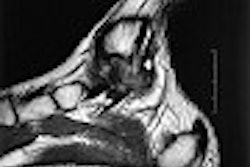
(Outpatient Care Technology) Ultrasound looks to be unstoppable. Advances in both technology and equipment have been tremendous in recent decades, and the growth and refinement of these tools is expected to continue. So the question is, what does it take to remain on the cutting edge in a specialty that never slows down?
Some of the tech talk can be overwhelming. Vendors must strike a balance between the technology that is available and what their customers actually need, according to Dave Willis, director of product strategy at SonoSite of Bothell, WA. "Too many features make (these) machines too complicated."
Dan Walton, vice president of sales and marketing at SonoSite, agreed. But one feature he would never dream of compromising is portability. "Doctors need a point-of-care system (that they can) carry to different sites," Walton said. SonoSite offers some systems that can be parked in a stand and used as a desktop unit, or simply taken to the patient’s bedside.
WomanCare, P.C., an ob/gyn practice in suburban Chicago, is "always looking for better resolution in smaller machines," according to one ultrasound specialist there. In fact, resolution, portability, and cost are three key considerations that influence purchasing decisions for this practice.
Ultrasound in the office
"In the office market, it is important that the clinicians have the tools required to fulfill their clinical objectives within the context of patient management," said Jim Chapman, director of marketing at Biosound Esaote in Indianapolis. "It is certainly possible to exceed this requirement, but (that may) increase the cost of service without offering tangible benefits."
Chapman believes the most important features for office settings include:
- Imaging performance.
- User friendliness/ergonomics.
- Comprehensive reporting features.
- Excellent pricing and performance.
SonoSite recommends that doctors look for excellent image quality, durability, reliability, and usability. In addition, they should consider whether the system is upgradeable. Today, upgrading ultrasound equipment can be quite simple, Willis said. "We can send customers a compact flash card -- much the same as (that of) a digital camera -- and they can use it to upgrade their system." This is a relatively new way of upgrading systems. "(Doctors) used to need a service rep to come in and upgrade a system," he said. "Now they use flash cards."
Although vendors such as SonoSite offer products that are upgradeable, many systems five years or older cannot be updated. "This is a concern," said Victor Reddick, senior vice president and general manager of ultrasound at Philips Medical Systems in Andover, MA. "It makes economic sense for doctors to upgrade. But, as the technology (continues to) change, this isn’t always possible."
It can be difficult to justify a financial investment in older equipment. "In the office environment, where the capital outlay for equipment is relatively low, I think replacing equipment (every five years) makes some sense," Chapman said. "The more sophisticated technology tends to migrate down to the less expensive products with time. Yet, the technology architecture of the (older,) less sophisticated systems often won’t support these new capabilities without extensive upgrading. It is probably less expensive and more efficient to simply replace the unit," he said.
Price points
Given the wide cost range of new ultrasound systems, purchasing decisions should be dictated by the type of ob/gyn practice, the volume of patients, and the degree of resolution a doctor depends on, Reddick said. "In a (small) obstetrical office where a doctor can’t afford state-of-the-art machines, (he or she) can add a great deal to the quality of care and the ability to diagnose with less sophisticated equipment," he said. Doctors can send patients to specialists for higher-level diagnoses.
WomanCare, P.C., for example, does not have an in-house Doppler system. While the practice acknowledges that Doppler technology is very useful in diagnosing growth-restricted fetuses, these cases are farmed out to a perinatologist.
Office-based practices often can fill their patients’ needs with black-and-white ultrasound units starting at $35,000. WomanCare, P.C. uses machines in the $35,000 to $40,000 price range. To make the leap to color or Doppler systems, a practice may spend closer to $70,000. Upper-end users generally can spend between $100,000 and $150,000 -- if not more -- for state-of-the-art and 4-D systems.
Real-time results
Among the newest advances in ultrasound is the capacity of some systems to provide three-dimensional images in real time. This is an exciting time for obstetrical ultrasound, said Jeff Peiffer, marketing manager for GE Medical Systems -- Ultrasound Americas in Waukesha, WI. "There are (some) new things happening," he said. For one, although 2-D images have provided real-time images for some time, it is only recently that doctors have been able to put 3-D images in real time, providing a 4-D image of anatomical structures.
"Also, in the past, doctors could see an anatomic cross-section, not a 3-D view," Peiffer continued. Today, machines provide 3-D images as quickly as eight to 12 -- or even 20 -- frames per second, giving doctors a much-improved anatomical view of the body.
Four-dimensional technology takes ultrasound to yet another level, Peiffer said. Not only do these systems have the capacity to identify more symptoms or problems in higher-risk pregnancies, the technology can even affect maternal bonding. "The patient actually sees the baby (with 4-D ultrasound)," Peiffer said. "This is a whole different experience for the mother, and some doctors are studying this relationship."
Future waves
Vendors predict a number of exciting advances in ultrasound over the next five-plus years. In addition to further refinement of 3-D and 4-D technology, they anticipate even more sophisticated imaging, a continued focus on portability, and higher speed. Even today, SonoSite offers machines that boot up in just over 10 seconds, according to Willis.
Philips Medical offers equipment that is more ergonomically functional, Reddick said. "We have improved the shape of the transducer and the control panel layout, and have made the system much more adjustable and mobile," he explained. In addition, the company is reportedly producing equipment that is easier to operate, enabling the sonographer to capture a better-quality image and improve patient throughput.
Structural reporting is another area that Philips Medical has developed for the smaller ob/gyn practice. "Our new EnVisor system, for example, has sophisticated, structured reports that are online and exportable to a picture archival imaging network or CD," Reddick noted. "This will make it easier for doctors to do trending (based on multiple exams) and store reports for easy retrieval."
Observed Peiffer: "There have been dramatic improvements in ultrasound technology, but we really believe that we are just touching the surface. The next five years in ultrasound should prove more exciting than the last 20."
By Laura Thill
AuntMinnie.com contributing writer
November 7, 2003
Laura Thill is a contributing editor to Outpatient Care Technology, where this article was originally published. For more information about OCT, go to http://www.opctonline.net.
Copyright © 2003 Outpatient Care Technology



















